#Jain religion
Text
Understanding Devotional Worship: A Path to Spiritual Fulfillment
Devotional worship is a profound practice that has been a part of human culture for centuries. It is a way for individuals to connect deeply with the divine, expressing their love, reverence, and faith. Whether you are new to this practice or seeking to deepen your understanding, this guide will provide insights into the essence of devotional worship and how platforms like omtvlive can enhance your spiritual journey.

What is Devotional Worship?
Devotional worship refers to acts of devotion directed towards a deity or higher power. These acts can include prayer, singing hymns, chanting mantras, meditating, and performing rituals. The purpose of devotional worship is to express love and gratitude to the divine, seek guidance, and find spiritual solace.
Benefits of Devotional Worship
Inner Peace: Engaging in devotional worship helps calm the mind and bring inner peace. It provides a break from daily stresses and allows individuals to focus on the divine presence.
Spiritual Growth: Regular practice fosters spiritual growth. It deepens one's faith, enhances understanding of spiritual principles, and strengthens the connection with the divine.
Emotional Well-Being: Devotional worship can be a source of comfort during challenging times. It helps in coping with emotions like fear, anxiety, and sadness by providing a sense of hope and reassurance.
Community Connection: Participating in devotional worship within a community can create a sense of belonging and support. It brings people together in a shared expression of faith and devotion.
Forms of Devotional Worship
Devotional worship can take many forms, each with its own unique practices and traditions. Here are some common forms:
Prayer: A fundamental aspect of devotional worship, prayer involves communicating with the divine. It can be a request for help, an expression of gratitude, or simply a way to feel closer to the higher power.
Chanting and Singing: Chanting mantras or singing hymns and bhajans are powerful ways to engage in devotional worship. The repetitive nature of chanting helps focus the mind and create a meditative state.
Meditation: Meditation is a silent form of devotional worship where individuals sit quietly, focus on the divine, and cultivate a sense of inner stillness and connection.
Rituals and Offerings: Performing rituals and making offerings are traditional practices in many religions. These acts symbolize devotion and reverence towards the deity.
Pilgrimages: Traveling to sacred sites and participating in religious festivals are also forms of devotional worship. These journeys often provide a deep sense of spiritual renewal.
Enhancing Devotional Worship with Omtvlive
In today’s digital age, accessing resources for devotional worship has become easier than ever. Platforms like omtvlive play a crucial role in bringing devotional content to people worldwide. Here’s how omtvlive can enhance your devotional worship experience:
Live Streaming: Omtvlive offers live streaming of religious ceremonies, prayers, and spiritual discourses. This allows you to participate in devotional worship from the comfort of your home, especially if you cannot visit a place of worship.
On-Demand Content: The platform provides a wide range of on-demand content, including recorded prayers, bhajans, and spiritual talks. You can access these resources anytime, making it convenient to incorporate devotional worship into your daily routine.
Community Engagement: Omtvlive fosters a sense of community by connecting viewers with like-minded individuals. You can participate in live chats, discussions, and virtual prayer sessions, creating a shared space for devotion and support.
Educational Resources: The platform offers educational content that helps deepen your understanding of various aspects of devotional worship. This can include explanations of rituals, the significance of festivals, and teachings from spiritual leaders.
Diverse Practices: Omtvlive caters to a wide range of religious and spiritual traditions. This diversity allows you to explore different forms of devotional worship and find what resonates most with your spiritual path.
Tips for Deepening Your Devotional Worship
If you want to deepen your devotional worship, consider these tips:
Consistency: Make devotional worship a regular part of your routine. Consistent practice helps cultivate a stronger connection with the divine.
Sincerity: Approach devotional worship with sincerity and an open heart. Genuine devotion enhances the spiritual experience.
Learn and Explore: Use platforms like omtvlive to learn about different practices and traditions. Exploring various forms of devotional worship can enrich your spiritual journey.
Create a Sacred Space: Designate a quiet, clean space in your home for devotional worship. This can help you focus and create a peaceful environment for your practice.
Connect with Others: Engage with your spiritual community, whether online through omtvlive or in person. Sharing your experiences and learning from others can be incredibly enriching.
Conclusion
Devotional worship is a beautiful and meaningful way to connect with the divine and nurture your spiritual growth. It offers numerous benefits, from inner peace to a stronger sense of community. Platforms like omtvlive make it easier than ever to access devotional content and enhance your practice. By incorporating devotional worship into your daily life and exploring the resources available through omtvlive, you can embark on a fulfilling spiritual journey filled with love, devotion, and enlightenment.
#vedic philosophy#classical hinduism#hindu philosophy#hindu religion philosophy#hindu vedanta#jnana yoga#advaita vedanta philosophy#advaita vedanta in hindi#vaishnava tradition#jain religion#tantric traditions#vedic religion#devotional worship#modern hinduism#vedic scriptures#spiritual realization#dharmic religions#indian religions
2 notes
·
View notes
Text
Understanding Classical Hinduism: A Journey Through Ancient Beliefs
Classical Hinduism is one of the oldest and most diverse religious traditions in the world. It encompasses a rich tapestry of beliefs, practices, and rituals that have evolved over thousands of years. This blog will guide you through the essential aspects of Classical Hinduism, shedding light on its core principles, major texts, and how it continues to influence people today. Along the way, we'll also touch on a resource called OMTVLive, which provides insightful content related to this ancient religion.

What is Classical Hinduism?
Classical Hinduism refers to the set of religious practices and philosophies that developed in ancient India. It is characterized by its deep spiritual teachings, extensive rituals, and a vast array of deities and myths. Unlike many other religions, Classical Hinduism does not have a single founder or a central text. Instead, it is a collection of diverse beliefs that have coalesced over centuries.
Major Texts of Classical Hinduism
The foundation of Classical Hinduism lies in its sacred texts, which are divided into two main categories: Shruti and Smriti. The Shruti texts, which include the Vedas and the Upanishads, are considered the most authoritative. They consist of hymns, prayers, and philosophical discussions. On the other hand, the Smriti texts are more accessible and include the epics like the Mahabharata and Ramayana, as well as the Puranas.
For those interested in exploring these texts further, resources like OMTVLive offer detailed explanations and analyses. OMTVLive provides content that delves into the meanings of these ancient scriptures and how they relate to contemporary life.
Key Beliefs of Classical Hinduism
Dharma: One of the core concepts in Classical Hinduism is Dharma, which refers to the moral order and duties that one must follow. This concept helps guide individuals in making ethical decisions and living a righteous life.
Karma: Another important belief is Karma, the principle of cause and effect. According to this belief, every action has consequences, and one's past actions influence their future experiences.
Moksha: The ultimate goal in Classical Hinduism is Moksha, or liberation from the cycle of rebirth (samsara). Achieving Moksha means attaining a state of eternal peace and unity with the divine.
Rituals and Practices
Classical Hinduism is known for its elaborate rituals and ceremonies. These rituals vary widely but often involve offerings to deities, chanting of mantras, and participation in festivals. Temples play a significant role in these practices, serving as places where individuals can worship and seek guidance.
OMTVLive offers a range of videos and articles that showcase various rituals and festivals in Classical Hinduism. These resources provide a vivid depiction of how these ancient practices are performed and their significance in the daily lives of practitioners.
Deities and Mythology
The pantheon of deities in Classical Hinduism is vast and includes gods and goddesses like Brahma, Vishnu, Shiva, Lakshmi, and Saraswati. Each deity represents different aspects of life and the universe, and devotees often worship specific deities based on their personal needs and goals.
The mythology surrounding these deities is rich and complex, with numerous stories that convey moral and spiritual lessons. OMTVLive is a valuable resource for those who wish to learn more about these myths and their meanings. The platform provides detailed explanations of various stories and their relevance to Classical Hinduism.
Modern Influence and Practice
Classical Hinduism is not just a historical tradition; it continues to influence millions of people around the world today. In modern India, Classical Hinduism shapes daily life, cultural practices, and national festivals. It also impacts the global Hindu diaspora, which maintains and adapts these ancient traditions in new contexts.
For a contemporary perspective on Classical Hinduism, OMTVLive offers modern interpretations and discussions that help bridge ancient practices with current lifestyles. This platform provides valuable insights into how Classical Hinduism is practiced and understood in today's world.
Conclusion
Classical Hinduism is a profound and intricate tradition that has shaped the spiritual and cultural landscape of India for millennia. Its teachings on Dharma, Karma, and Moksha offer valuable guidance for living a meaningful life. Through its sacred texts, rituals, and deities, Classical Hinduism provides a rich tapestry of beliefs that continue to resonate with people today.
For those interested in exploring Classical Hinduism further, OMTVLive serves as an excellent resource. It offers in-depth content that helps illuminate the complexities of this ancient religion and its relevance in the modern world. Whether you're looking to understand ancient texts, explore rituals, or learn about deities, OMTVLive provides a wealth of information to enhance your journey into Classical Hinduism.
By delving into the teachings and practices of Classical Hinduism, we gain a deeper appreciation for its enduring legacy and its role in shaping human spirituality and culture across the ages.
#vedic philosophy#classical hinduism#hindu philosophy#hindu religion philosophy#hindu vedanta#jnana yoga#advaita vedanta philosophy#advaita vedanta in hindi#vaishnava tradition#jain religion#tantric traditions#vedic religion#devotional worship#modern hinduism#vedic scriptures#spiritual realization#dharmic religions#indian religions
0 notes
Text
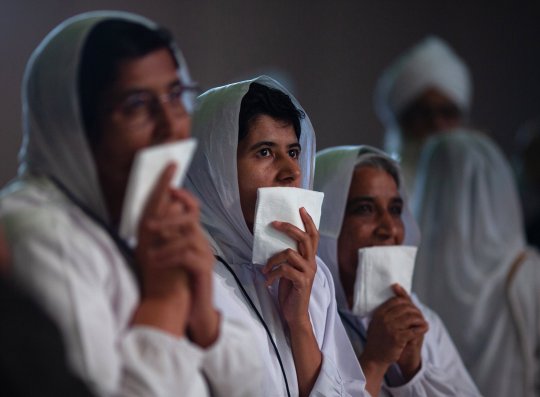
Jain nuns participate in a climate repentance ceremony at the Parliament of the World’s Religions in Chicago on Aug. 15, 2023. Photo by Lauren Pond for RNS
#religion#jainism#jains#nuns#women#people#parliament of the world's religions#united states#divinum-pacis
57 notes
·
View notes
Text

« Jain Cosmological Map of the Universe - Jambudvipa » [Artist not mentioned]
« Jambudvīpa is the dvipa ("island" or "continent") of the terrestrial world, as envisioned in the cosmologies of Hinduism, Buddhism, and Jainism, which is the realm where ordinary human beings live. »
#art#artwork#painting#paintings#cosmology#jambudvipa#jainism#jain cosmology#religious art#religion#universe#maps#manuscript maps
18 notes
·
View notes
Text

Interior of the Jain Shwetamber Temple of Shri Chintamani Parshavnath Ji in Agra, India.
Via Jordan Quill
21 notes
·
View notes
Text
Evidence of circumambulation in other civilizations before South Asia
ANCIENT EGYPT
Circumambulation was an important part of religious rituals, particularly those associated with the worship of the sun god Ra. The earliest evidence of circumambulation in Egypt comes from the Pyramid Texts, a collection of ancient Egyptian funerary texts that were inscribed on the walls of royal tombs during the Old Kingdom period (c. 2686–2181 BCE). These texts describe the journey of the deceased king through the afterlife, including a ritual circumambulation of the tomb.
MESOPOTAMIA
In the Sumerian hymn "Inanna and Ebih," which dates to around 2300 BCE, there is a description of Inanna, the goddess of love and war, circling the "holy altar" in a ritual dance. The text describes the altar as a "lapis lazuli mountain" and Inanna as "circling the shining lapis lazuli mountain."
"Lamentation Over the Destruction of Ur", which is a Sumerian poem that dates back to around 2000 BCE. In this poem, the goddess Inanna is described as performing a ritual circumambulation around the city of Ur as she mourns its destruction.
Another example is the "Hymn to Enlil" from Nippur, which dates back to the early second millennium BCE. In this hymn, the god Enlil is praised for his power and wisdom, and the poet describes how people circle around his temple in a ritual of reverence and devotion. It also describes priests circling the temple as part of a purification ritual.
There are also references to circumambulation in Babylonian texts, which were written in a later period. For example, in the "Epic of Gilgamesh", which dates back to around 1800 BCE, the hero Gilgamesh is said to have performed a ritual circumambulation around the walls of Uruk. There is a scene in which Gilgamesh and Enkidu circle a sacred fire altar in a ritual dance, as part of a ceremony to invoke the blessing of the gods. The text describes the altar as "a pure brickwork of square shape, perfect in its dimensions," and the dance as a way of "pleasing the heart of the god Shamash."
#Circumambulation#temple#temples#spirituality#history#prehistory#religion#hindu#hinduism#vedic#vedism#buddhist#buddhism#jain#jainism#ajivika#egypt#egyptian#ancient egyptian#mesopotamian#sumer#pyramid texts#pyramids#sumerian#mythology
2 notes
·
View notes
Text
#सत्संग_निमंत्रण
#SantRampalJiMaharaj
#SantRampalJi_AvataranDiwas

#nepal#america#religion#daily devotional#motivation#feeling motivated#faith in god#bible reading#buddhism#jain festival#follower of jesus christ#christian quotes#christian bible#follow jesus#i love jesus#jesusisgod#jesusislord
1 note
·
View note
Text
And sincerely, “christians” who want respect can find it once they stop molesting our government and respect secularism
#ive reached the bottom of my ‘respect’ barrel for all religions honestly#its all nonsense#its the same insane shit with muslims jews hindus buddhists jains#etc
0 notes
Text
Understanding Jain Religion and Its Beliefs

About Jain religion, one of the oldest Indian religions, is characterized by its emphasis on non-violence, truth, non-stealing, celibacy, and non-attachment. Rooted in ancient teachings, Jainism emphasizes the importance of Ahimsa, or non-violence, as a fundamental principle governing all aspects of life. Jains believe in the existence of a soul, which can attain liberation through the practice of non-violence and other ethical virtues.
Central to Jainism beliefs is the concept of Karma, which states that every action, whether physical, verbal, or mental, has consequences that affect one's future. Jains strive to live a life of purity and righteousness to accumulate good karma and progress towards spiritual liberation. Additionally, Jain beliefs include the idea of reincarnation, where the soul undergoes cycles of birth and death until it achieves Moksha, or liberation from the cycle of rebirth.
Jainism also teaches the importance of self-discipline, meditation, and asceticism as means to attain spiritual enlightenment. Jains follow a strict code of conduct known as the Five Great Vows, which include non-violence, truthfulness, non-stealing, celibacy, and non-attachment. By adhering to these principles, Jains seek to purify their souls and ultimately attain spiritual liberation.
In summary, Jain religion is characterized by its profound beliefs in non-violence, karma, reincarnation, and the pursuit of spiritual liberation. Through its teachings and ethical principles, Jainism offers a path to inner peace, moral conduct, and spiritual growth.
0 notes
Text
Buddhism and Christianity in the Future of the World...
Christianity was perhaps better to develop a raw wild unruly world. But Buddhism is better to sustain it. All of which avoids the issue of whether we will survive or not. But, isn’t it better to have developed the world and lost, than never to have developed it at all? Hmmm, I’m not sure, because it seems that we could have developed mentally, and consciously, without ever filling the landfills…

View On WordPress
#Alexander#Brahminists#Buddhism#CHRISTIANITY#FUTURE#Gymnosophists#Hardie Karges#India#Jains#language#Plato#Pythagoras#religion
0 notes
Text

पर्युषण पर्व
पर्युषण महा पर्व की हार्दिक शुभकामनाएं , ये पर्व हमारे मन की शुद्धता का ,अहिंषा के मार्ग पर चलने का , राग द्वेष मिटाने का ओर धर्म के मार्ग पर चलने का पर्व है!
#paryushan#jain#paryushanparv#jains#mahavir#palitana#gujarat#samvatsari#forgiveness#religion#temple#india
0 notes
Text
Modern Hinduism: Embracing Tradition and Change with Omtvlive
Modern Hinduism is a vibrant and dynamic blend of ancient traditions and contemporary practices. As one of the world's oldest religions, Hinduism has evolved significantly over thousands of years, adapting to changes in society while maintaining its core principles. In this blog, we will explore the essence of modern Hinduism, how it differs from traditional practices, and its relevance today. With insights from Omtvlive, we aim to provide a clear understanding of this fascinating subject.
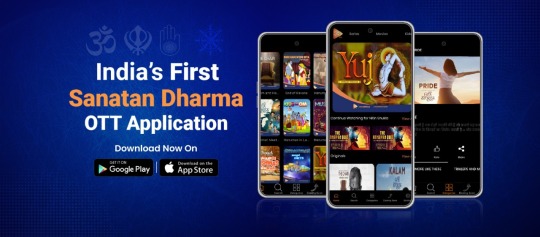
What is Modern Hinduism?
Modern Hinduism refers to the way Hinduism is practiced and understood in the contemporary world. It is a religion that remains deeply rooted in its ancient scriptures and traditions but also embraces new ideas and practices. This adaptation allows Hinduism to stay relevant and meaningful in the lives of its followers amidst the rapid changes of the modern world.
Key Aspects of Modern Hinduism
Continued Reverence for Scriptures Despite the passage of time, the sacred texts of Hinduism, such as the Vedas, Upanishads, Bhagavad Gita, and Ramayana, continue to hold great importance. These texts provide spiritual guidance and moral teachings that are timeless. Modern Hindusm study these scriptures to understand the deeper meanings of life and the universe.
Flexibility in Practices One of the strengths of modern Hinduism is its flexibility. While traditional rituals and ceremonies remain important, many Hindus adapt these practices to fit their contemporary lifestyles. For example, daily prayers (puja) might be performed in simpler forms, and festival celebrations may incorporate modern elements while retaining their spiritual essence.
Focus on Personal Spirituality Modern Hinduism places a strong emphasis on personal spirituality and inner growth. Practices such as yoga, meditation, and mindfulness are widely embraced. These practices help individuals connect with their inner selves and achieve a sense of peace and balance in their busy lives. According to Omtvlive, this focus on personal spirituality is one of the key ways Hinduism remains relevant today.
Social and Ethical Concerns Modern Hinduism addresses contemporary social and ethical issues, emphasizing the importance of dharma (righteousness) in everyday life. This includes promoting environmental sustainability, social justice, and ethical behavior. Many Hindu organizations and leaders actively engage in humanitarian efforts, reflecting the religion’s enduring commitment to compassion and service.
The Role of Technology and Media
Technology and media have significantly influenced modern Hinduism. Platforms like Omtvlive play a crucial role in disseminating spiritual knowledge and connecting Hindus worldwide. Online resources, virtual temples, and social media communities have made it easier for people to access religious content, participate in rituals, and engage with spiritual leaders from the comfort of their homes.
The Global Spread of Hinduism
Modern Hinduism is not confined to India; it has a global presence. The Hindu diaspora has spread to various parts of the world, including North America, Europe, and Southeast Asia. This global spread has led to the blending of Hindu practices with local cultures, creating diverse expressions of the religion. Festivals like Diwali and Holi are celebrated with great enthusiasm worldwide, bringing together people from different backgrounds to appreciate Hindu culture.
Modern Hinduism and Interfaith Dialogue
In today’s interconnected world, interfaith dialogue is essential for promoting mutual understanding and harmony. Modern Hinduism actively participates in such dialogues, fostering respect and cooperation among different religious communities. This openness to other faiths is rooted in Hinduism’s inclusive philosophy, which acknowledges multiple paths to the divine.
Challenges and Adaptations
While modern Hinduism has adapted well to contemporary times, it also faces challenges. The rapid pace of globalization and modernization can sometimes lead to a dilution of traditional values and practices. However, many Hindu leaders and scholars are working to address these challenges by finding ways to preserve the essence of the religion while embracing change.
Omtvlive highlights that education and awareness are key to maintaining the balance between tradition and modernity. By educating young Hindus about their rich cultural heritage and encouraging them to explore their spirituality, the continuity of Hinduism can be ensured for future generations.
The Future of Modern Hinduism
The future of modern Hinduism looks promising as it continues to evolve and adapt. With its emphasis on personal spirituality, ethical living, and social responsibility, Hinduism remains a guiding force for millions. The integration of technology and media will likely play an even greater role in the spread and practice of Hinduism, making it more accessible and inclusive.
According to Omtvlive, the future of modern Hinduism will be shaped by its ability to maintain its core values while embracing innovation and change. This adaptability will ensure that Hinduism remains a living, breathing tradition that speaks to the needs and aspirations of people in the modern world.
Conclusion
Modern Hinduism is a beautiful blend of ancient wisdom and contemporary relevance. It continues to guide its followers with timeless principles while adapting to the changes of modern life. With the help of platforms like Omtvlive, the teachings and practices of Hinduism are more accessible than ever, fostering a deeper understanding and connection among Hindus around the world.
By embracing both tradition and change, modern Hinduism offers a path that is both spiritually enriching and practically relevant, ensuring its enduring significance in an ever-evolving world.
#vedic philosophy#classical hinduism#hindu philosophy#hindu religion philosophy#hindu vedanta#jnana yoga#advaita vedanta philosophy#advaita vedanta in hindi#vaishnava tradition#jain religion#tantric traditions#vedic religion#devotional worship#modern hinduism#vedic scriptures#spiritual realization#dharmic religions#indian religions
0 notes
Text
Dharmic Religionss: A Journey into Ancient Beliefs
Dharmic Religionss is a term used to describe a group of religions that originated in the Indian subcontinent. These include Hinduism, Buddhism, Jainism, and Sikhism. These religions share common beliefs and practices, focusing on the concept of "dharma," which means duty, righteousness, and moral law. Let's explore the fascinating world of Dharmic Religionss and understand how they shape the lives of millions of people.

Hinduism: The Oldest Dharmic Religion
Hinduism is the oldest of the Dharmic Religions, with roots that go back over 4,000 years. It is a complex religion with a variety of gods and goddesses, rituals, and philosophies. The core belief in Hinduism is the idea of dharma, which means living in accordance with one's duty and righteousness. Hindus believe in reincarnation, where the soul is reborn in a new body after death. The ultimate goal is to achieve moksha, or liberation from the cycle of rebirth.
Hinduism has many sacred texts, including the Vedas, Upanishads, and the Bhagavad Gita. These texts provide guidance on how to live a righteous life. Temples, festivals, and pilgrimages are also important aspects of Hindu worship. One popular festival is Diwali, the festival of lights, which symbolizes the victory of light over darkness.
Buddhism: The Path to Enlightenment
Buddhism is another significant Dharmic Religion. It was founded by Siddhartha Gautama, known as the Buddha, in the 5th century BCE. Buddhism teaches that life is full of suffering caused by desire and attachment. To overcome this suffering, one must follow the Eightfold Path, which includes right understanding, right thought, right speech, right action, right livelihood, right effort, right mindfulness, and right concentration.
Buddhists seek to attain Nirvana, a state of ultimate peace and enlightenment. Meditation is a key practice in Buddhism, helping individuals to develop mindfulness and insight. The teachings of the Buddha are collected in the Tripitaka, also known as the Pali Canon.
Jainism: The Path of Non-Violence
Jainism is another ancient Dharmic Religion that emphasizes non-violence (ahimsa) and self-discipline. Founded by Mahavira in the 6th century BCE, Jainism teaches that every living being has a soul and deserves respect. Jains follow five main vows: non-violence, truthfulness, non-stealing, celibacy, and non-possession.
Jain monks and nuns lead a strict ascetic lifestyle, renouncing worldly possessions and practicing intense meditation. Lay Jains also follow these principles, though in a less rigorous manner. Jain temples, known for their intricate architecture and sculptures, are places of worship and meditation.
Sikhism: The Religion of the Gurus
Sikhism is the youngest of the Dharmic Religionss, founded in the 15th century by Guru Nanak Dev Ji. Sikhism emphasizes devotion to one God, equality, and service to humanity. The teachings of the ten Sikh Gurus are compiled in the Guru Granth Sahib, the holy scripture of Sikhism.
Sikhs gather for worship in Gurdwaras, where they participate in prayer, singing hymns, and community service. One key practice in Sikhism is the Langar, a community kitchen where free meals are served to all, regardless of religion or background. This practice embodies the Sikh values of equality and selfless service.
The Influence of Dharmic Religionss
Dharmic Religionss have a profound impact on the culture and daily life of millions of people. They influence art, literature, music, and social customs. Festivals like Diwali, Vesak, Mahavir Jayanti, and Vaisakhi bring communities together, fostering a sense of unity and celebration.
Furthermore, the principles of dharma, non-violence, and compassion taught by these religions contribute to a more harmonious society. The emphasis on meditation and mindfulness has also gained global recognition, promoting mental well-being and inner peace.
Conclusion
Dharmic Religionss offer a rich tapestry of beliefs and practices that guide individuals on a path of righteousness and spiritual growth. Whether it's the ancient rituals of Hinduism, the mindful practices of Buddhism, the non-violent principles of Jainism, or the devotional worship in Sikhism, each religion provides a unique way to connect with the divine and achieve a meaningful life.
Exploring Dharmic Religionss helps us appreciate the diversity and depth of human spirituality. By understanding and respecting these ancient traditions, we can foster greater tolerance and harmony in our world.
For more insights into Dharmic Religions and their impact on modern life, visit omtvlive. Here, you will find a wealth of information and resources to deepen your understanding and appreciation of these profound spiritual paths. Remember, the journey to spiritual enlightenment and inner peace is a continuous process, and Dharmic Religionss offer timeless wisdom to guide us along the way. So, stay curious, keep exploring, and let omtvlive be your companion in this spiritual journey.
#vedic philosophy#classical hinduism#hindu philosophy#hindu religion philosophy#hindu vedanta#jnana yoga#advaita vedanta philosophy#advaita vedanta in hindi#vaishnava tradition#jain religion#tantric traditions#vedic religion#devotional worship#modern hinduism#vedic scriptures#spiritual realization#dharmic religions#indian religions
1 note
·
View note
Text
The Magic of Siri: A Jain Perspective on Accurate Representation
Introduction:
As a Jain individual, I have always valued the principles of non-violence, compassion, and respect for all living beings that form the foundation of our ancient religion. Recently, news about a web-series titled “The Magic of Siri” caught the attention of the Jain community due to concerns about its portrayal of Jainism. In this blog, we will delve into the aspects that have raised…

View On WordPress
#Accurate Representation#Compassion#Cultural Sensitivity#Cultural Understanding#Diksha Ceremony#empathy#Harmonious Society#Jain Community#Jain Way of Life#Jainism#Media Representation#Minority Religion#Misconceptions#Non-Violence#Religious Beliefs#Respectful Portrayal#Responsible Storytelling#The Magic of Siri#Web Series
0 notes
Text
Ok I get where everyone is coming from when they see the design of Pavitr ‘Pav’ Prabhakar aka Indian SpiderMan as an expression of gender queerness, but let me be frank this is very typical Indian male costuming.
Even the toxic masculine patriarchal men have similar stylistic expressions or to be be more precise this is a traditional/historical/ye olde male aesthetic.
Having said that I love what design elements are being used here. So…
Let's take it from the top.
The FACE MASK

The Three Colors surrounding the eyes are typical spider man colours but they are done to evoke the image the traditional makeup done for the ancient dance art Kathakali. In which the whole face is painted and bold lines are drawn to emphasise/exaggerate the eyes. These eye mask lines are usually thin - bold-thin.



Same with the white lines on the cheek bones which are indicative of tusks or pincers of demons or Animorphs in folklore/myths.



The white dot in the centre of the forehead is the most common Hindu motif, expressed in myriad of ways all over the country .
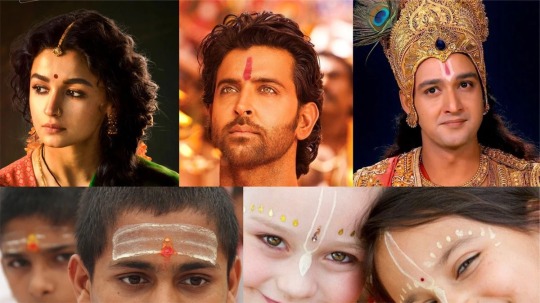
The ARM/LEG BANDS/CUFFS

The bicep cuff is a part of Indian historic armour - made of malleable metal, its bejewelled ornate counterparts were then worn in day to day life. Here in the north Royals still wear it during big ceremonies. These metal bands are generally worn by warriors.
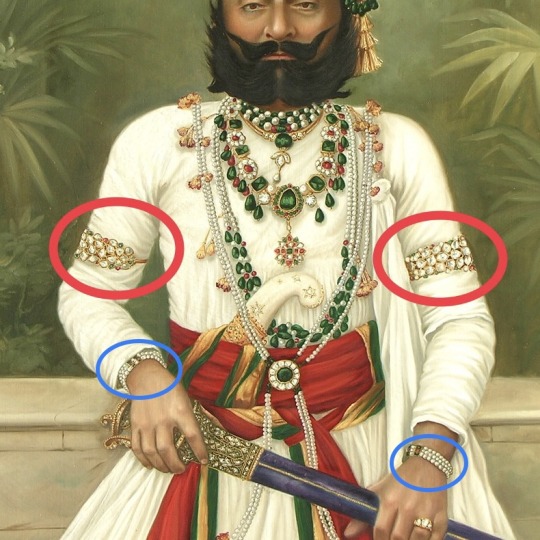

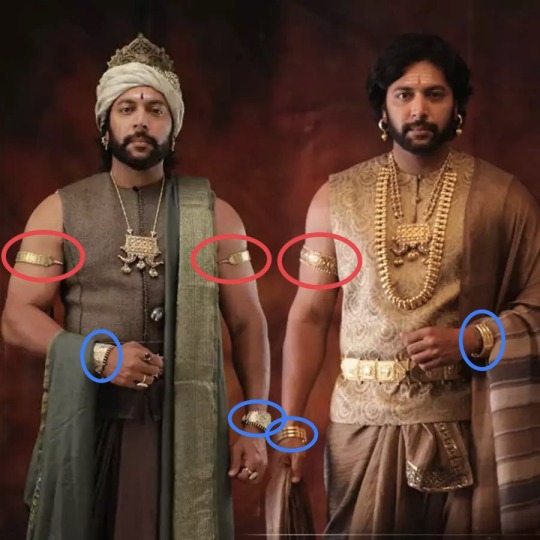
bangles (metal circles worn at wrists) are an important male accessory and are more daily wear even in present modern times, some religions (Sikh,Jain etc.) require the males to always wear one at all times. The ones on the suit were more in the shape of wrist guards which again were an armour accessory. In Indian male clothing the cuffs are usually emphasised.


Due to traditional male footwear being sandals metal ankle cuffs were employed to guard the shins and were worn during wars while thinner bands - ornamental accessories - were worn in daily wear.
There are so many other things I want to elaborate on like: The PATTERNS/LOGO,The LEG GARMENT (??!)(what’s the collective term for clothes for legs?), The Cat’s Cradle swinging/body animation ; but my ADHD is already acting up so imma leave this here.
SIDE NOTE:
I love how the heel and toes are bare in this design. It makes sense from the spider powers perspective - no barrier in contact allows for better manoeuvring and jump control as is seen in gymnastics. But also because in Hindu culture important tasks including some traditional sports require the removal of footwear and getting feet dirty is not discouraged (of course with an adherence to washing of the feet multiple times in a day)
I also loved how incorporated his wrist guard is in his spider style using it as a toy and a tool. This aspect of making use of something in a completely different way was so desi ‘Jugaad’ I was stunned.
#spiderman atsv#across the spiderverse#pavitr prabhakar#desi#design#letting my inner design nerd out#Indian warfare was my special interest#If you haven’t guessed by now#astv#desi experience#sony spiderverse#into the spider verse#Desi spiderman#indian spiderman
9K notes
·
View notes